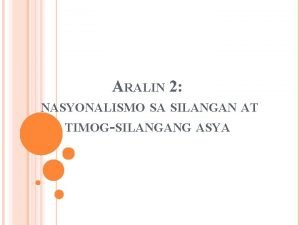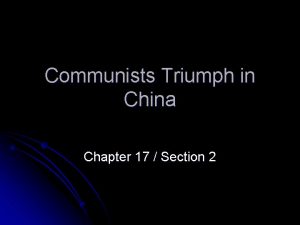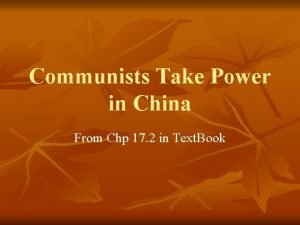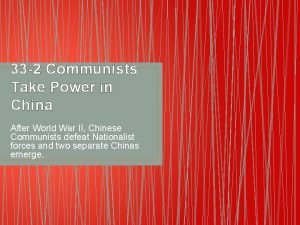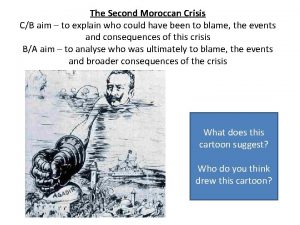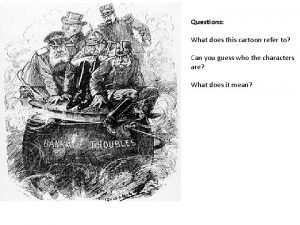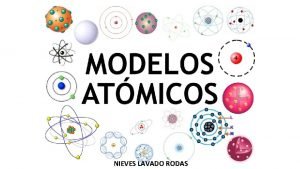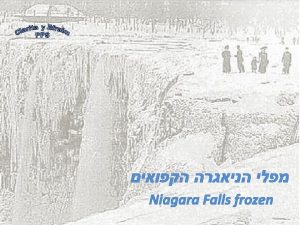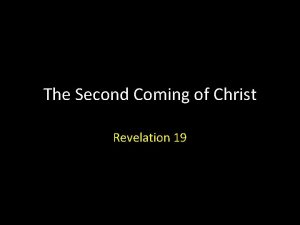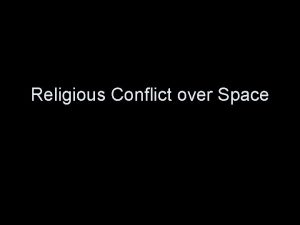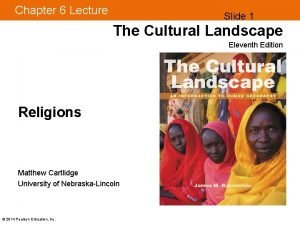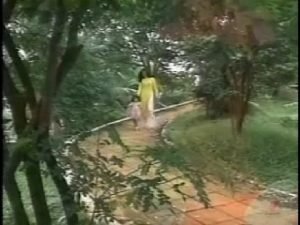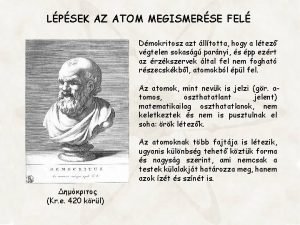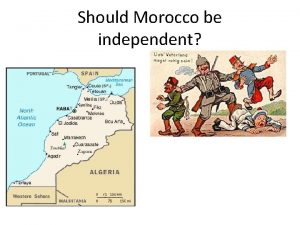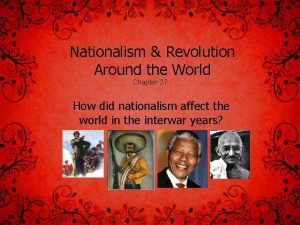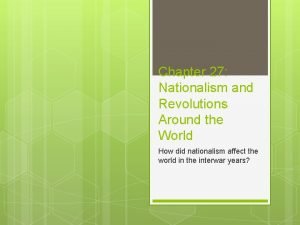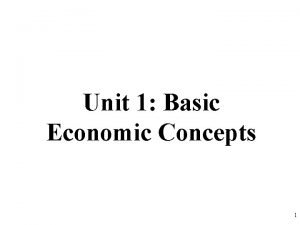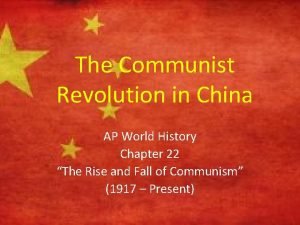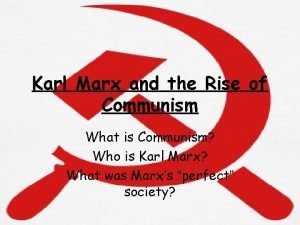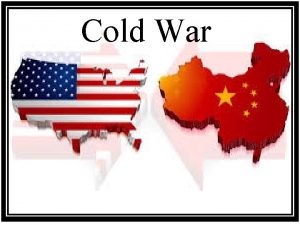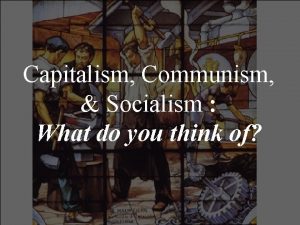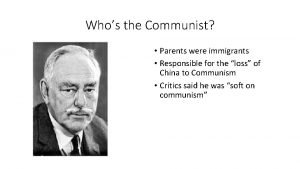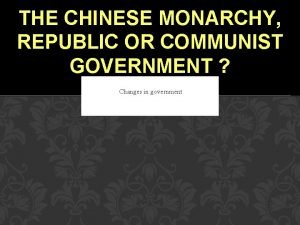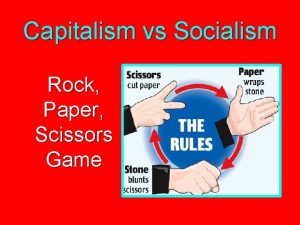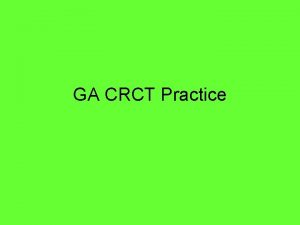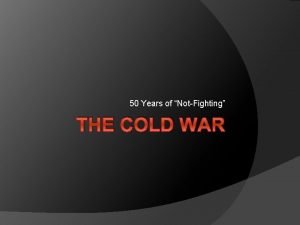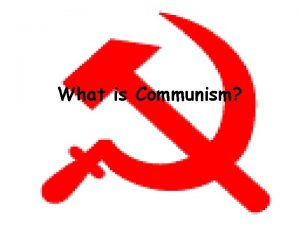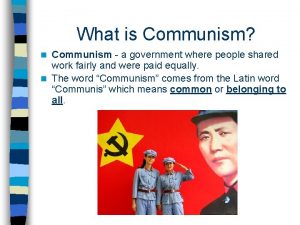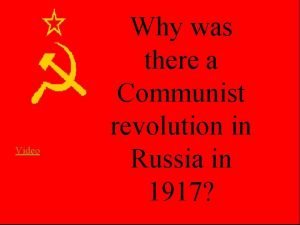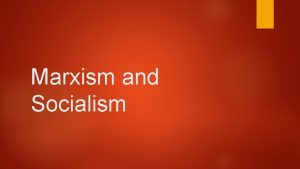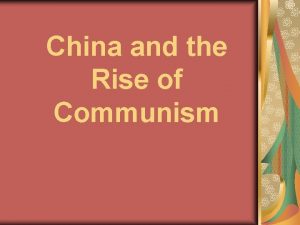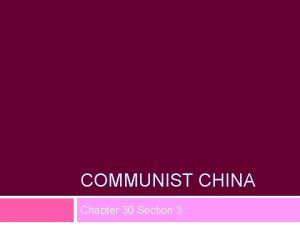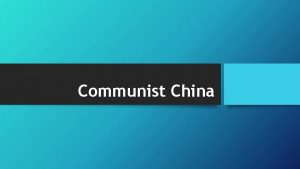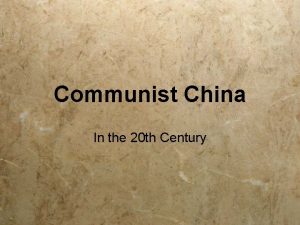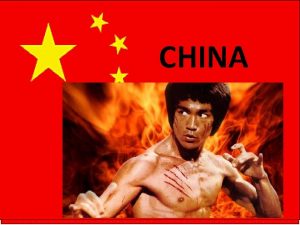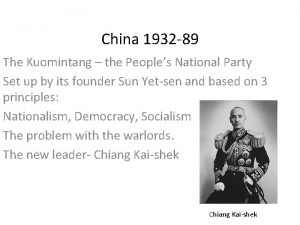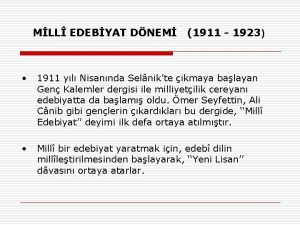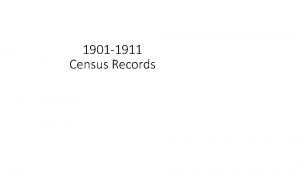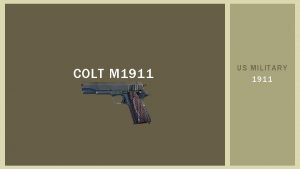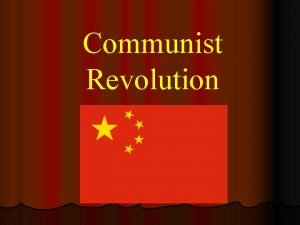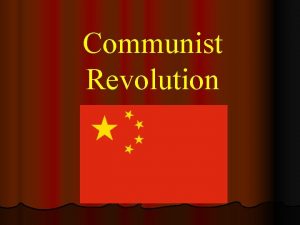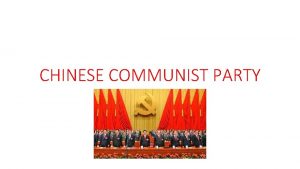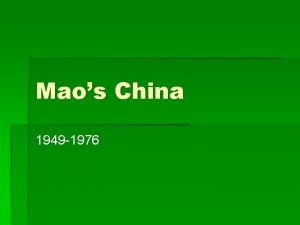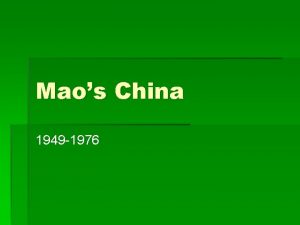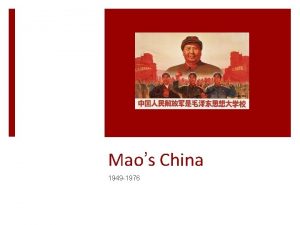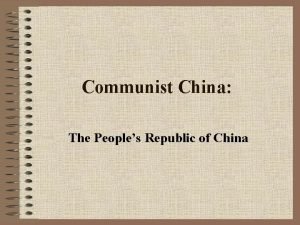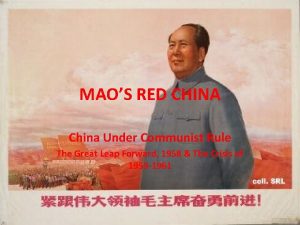COMMUNIST TAKE POWER IN CHINA Kuomintang Power 1911



































- Slides: 35

COMMUNIST TAKE POWER IN CHINA

Kuomintang Power | 1911 – Sun Yixian (Chinese Nationalist Movement) overthrows last emperor (Pu Yi)

“Three Principles of the People” | 1. Nationalism- an end to foreign control | 2. people’s rights- democracy | 3. people’s livelyhood- economic security for al Chinese “The Chinese people…do not have national spirit. Therefore, even though we have 4 million people gathered together in one China, in reality, they are just a heap of sand. ” –Sun Yixian

WWI – Allied Involvement |China was on the Allied side against Germany in WWI |Hope to regain lost lands from Germany

Betrayal | German territories given to Japan – not China | May 4, 1919 – May Fourth Movement – more people turn to communism

Developing… | While the Chinese Communist Party was forming | Sun Yixian and his nationalist party set up a government in South China | Yixian grew tired of the West’s empty promises to support his government

An Unlikely Alliance |In a hope for common action the Nationalists (Kuomintang) turn to the Communists |Mao Zedong…

Death, & a Sharp Right Turn |Sun died in ’ 25, Jiang Kai-Shek the new leader. |Fierce anticommunist…

Jiang Kai-Shek | Had promised democracy and political rights to all Chinese | Yet his government became steadily less democratic and more corrupt | Peasants believed that Jiang was doing little to help them | So the begin to support communism …and Mao

The Shanghai Massacre, 1927 |As Europe leaves, Jiang consolidates power and turns on communists to be unquestioned leader 34 warlords eliminated, and finally communists are targeted

A New War |With common enemies gone, Chiang preemptively turns on Mao. |War rages through late Chiang and Mao in Better Days 1920’s

1933 – The Long March | Nationalists & Communists were fighting a bloody Civil War | Mao began to enlist commoners into his “red army” | Cornered, Mao leads retreat for survival. | 90 K plus start it, 9 K finish it. | Communism on life support

The Nationalists Distracted | Japan had watched the power struggle in China and decided to launch an invasion | Japanese invasion of Manchuria (northern China) combined with Depression allow Mao to rest & survive. | This would force a temporary and uneasy truce between Mao and Japan Jiang’s forces to fight against Japan attacking

Mao Rebuilds Army in WWII |Under duress, Kuomintang and US use Mao as an ally. |Communists armed and building Mao with US Military in WWII strength…

Setting the Stage VS. | - Once again China fought for the Allies, this time in WWII | -During WWII, Japan’s armies occupied most of China | -China’s civilian death toll = 10 -22 million | -1945 the CCP and the Nationalists were at conflict again | This time the Nationalists are exhausted

| NATIONALIST | -aided by the U. S. | -controlled much of southern China | COMMUNIST | -mobilized peasants | -controlled much of northern China

Civil War Resumes 1946 -1949 | Nationalist were at an advantage by outnumbering Red Army 3: 1 | NO Popular support for Nationalists | Gradually Nationalist control collapsed | Mao gained control with the retreat of Chiang to Taiwan | People’s Republic of China is declared in 1949

U. S. Anti-Communist feelings | Chinese and Soviets sign Treaty of Friendship in 1950 | U. S. viewed this as another step in Communist campaign to conquer the world

China divided | Taiwan= Nationalist China | -U. S. aided | Mainland=People’s Republic of China | -Soviet Union aided

China Expands | Mao looked to conquer Mongolia, India, Tibet | 1950 -1951 Chinese attacked Tibet | Dalai Lama was forced to flee to India

New Mandate of Heaven | Mao ruled Communist party and national government | Used Marxist Socialism to reform Chinese economy | Killed more than 1 million landlords by using the Agrarian Reform Law in 1950

Marxist Socialism | Created collective farms | Private companies became nationalized | 5 year plan=production goals for industry

Laogai | “Re-Education” through labor | Live the life of peasant | Work People to death

The Great Leap Forward | Expand the success of the 5 year plans | Communes-collective farms | 15, 000 acres and 25, 000 people | Communal living

Giant step backward | Poor planning and inefficient industry | Ended in 1961 after crop failure caused famine that killed 20 million people

Great Leap Forward | Says failures from ’ 55 because he wasn’t bold enough… | Collectives build public works projects |Mao’s attempt to catch up with the rest of the world

New Policies and Mao’s Response | External problems | -territorial disputes | -communist movement | Internal problems | -lack of cooperation | -failure of Great Leap | Mao reduces his role in government | Farm families could sell crops | Live in their own homes | Factory workers competed for wages

“Learn Revolution by Making Revolution” | Mao felt new policies weakened Communist goal of social equality | Millions of high school and college students left classrooms and formed militia units called the Red Guards | Wanted to revive the revolution in 1966

The Cultural Revolution | Red Guards led the Cultural Revolution | Goal: establish a society of peasants and workers in which all were equal

The Cultural Revolution | New Hero: peasants who worked with their hands | Intellectual activity and art: useless and dangerous | Schools and colleges: | Resistance to the regime: | Purification in hard labor camps | Execution shut down | Imprisonment

| Chaos threatened farm production and closed down factories | Civil War seemed possible | Mao ordered put down Red Guards | Zhou Enlai-Chinese premier since 1949 began to restore order | Cold War continued to rage on

http: //www. youtube. com/watch? v=ef. BQKHOf. W 60

Year 1945 Nationalist Communist Leader Area Ruled Foreign Support Domestic Policy Public Support Military Organization

Year 1945 Nationalist Jiang Jieshi Southern China Communist Leader Area Ruled Mao Zedong Northern China United States Foreign Support Soviet Union Defeat of Communists Domestic Policy National Liberation Weak due to inflation and failing economy Public Support Strong due to promised land reforms for peasants Ineffective, corrupt leadership and poor morale Military Organization Experienced, motivated guerrilla army

A National Hero Wanted Design a commemorative plaque for Mao On the back create a “Wanted Poster” Zedong describing him as a National Hero from the nationalist perspective from the communist perspective Write: (Make up your own) All of China should recognize the great accomplishments of Mao Zedong, a hero to us all. | Then list 4 reasons positive accomplishments of Mao Write: (Make up your own) Be on the look out for the ruthless, devious, dictator. Mao is wanted for: -Then list at least 4 reasons why Mao is wanted
 Nasyonalismo ng silangang asya
Nasyonalismo ng silangang asya Chapter 17 section 2 communists take power in china
Chapter 17 section 2 communists take power in china Chapter 17 section 2 communists take power in china
Chapter 17 section 2 communists take power in china Chapter 33 section 2 communists take power in china
Chapter 33 section 2 communists take power in china Moroccan crisis cartoon
Moroccan crisis cartoon The first cartoons
The first cartoons Características del modelo de thomson
Características del modelo de thomson Niagara falls frozen 1911
Niagara falls frozen 1911 Revelation 19
Revelation 19 Ireland 1911
Ireland 1911 Ireland 1911
Ireland 1911 1911-1988
1911-1988 Fila heritage 1911
Fila heritage 1911 Mazsolás puding modell
Mazsolás puding modell Moroccan crisis 1911
Moroccan crisis 1911 When did mao take over china
When did mao take over china When did mao take over china
When did mao take over china Take a bus or take a train
Take a bus or take a train Marxism vs communism
Marxism vs communism Chinese communist revolution ap world history
Chinese communist revolution ap world history Chinese communist party ap world history
Chinese communist party ap world history Communism simple definition
Communism simple definition Communist and capitalist countries cold war
Communist and capitalist countries cold war What is a communism government
What is a communism government Communist parents
Communist parents Mr. bolanos
Mr. bolanos Communist monarchy
Communist monarchy Rock paper scissors communist game
Rock paper scissors communist game Which phrase best defines a mountain range?
Which phrase best defines a mountain range? All communist countries during the cold war
All communist countries during the cold war How to explain communism
How to explain communism Communist meaning
Communist meaning Communist revolution
Communist revolution Carthyism
Carthyism Socialism in sociology
Socialism in sociology Communist manifesto penguin
Communist manifesto penguin
